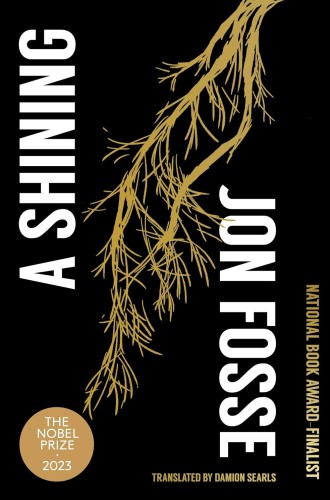A glimpse of the world beyond
In his new novella, Jon Fosse allows a luminous narrative to unfold at a dreamlike pace.

A Shining
Jon Fosse, a Norwegian novelist and playwright who just won the Nobel Prize for literature, begins his new novella, A Shining, in a way that evokes the opening lines of Dante’s Divine Comedy. The first-person narrator wanders away from familiar paths and gets lost in a dark wood. It is the beginning of one man’s journey toward God, a pilgrimage from darkness to light.
Fosse, an advocate for what he calls “slow prose,” allows his luminous narrative to unfold at a dreamlike pace. The narrator’s car gets stuck on a deeply rutted road in the forest. He walks to find help and gets lost. Along the way he perceives various manifestations of the holy—a light that is vested with personhood, a presence, a voice. In the most explicitly biblical reference, he asks the presence, “Who are you?” and is told, “I am who I am,” the same answer Moses received when he asked a similar question. Later, the narrator encounters his parents and, finally, a barefooted man dressed in a black suit who leads him into the light.
The ineffable nature of the narrator’s experience is conveyed through paradox. In this way, Fosse uses words to point to the limit of words. His parents look like his parents, and they don’t look anything like his parents. His mother’s voice is “both very nearby and very far away at the same time.” His experience is “like being locked into a closed room in the forest, trapped, but at the same time it’s like the room is unbounded.”
One humorous element in a book that otherwise is not long on humor is itself a kind of paradox. Although his parents radiate a kind of heavenly light, they also constantly bicker in the petty manner of people who can still get on each other’s nerves. It is a way of affirming that, as different as the afterlife may be from this life, in some sense people remain who they are.
The narrator’s description of his experience has much in common with descriptions of near-death experiences in best-selling nonfiction books such as Life after Life by Raymond Moody (1975) and Proof of Heaven by Eben Alexander (2012). There is the warm and beckoning light, the ability to see oneself as if at a distance, reunion with loved ones who have died, all accompanied by a sense of beatitude.
In fact, Fosse did have his own near-death experience that has influenced much of his writing and is most directly reflected in A Shining. When asked in an interview if he considers himself a mystic, Fosse replied,
This mystic side has to do with when I was seven years old and close to dying. It was an accident. I saw myself from the outside, in a kind of shimmering light, peaceful, a very happy state, and I’m quite sure that accident, that moment, that close-to-death experience formed me as a writer.
Fosse also testifies to the ways in which the writings of the medieval mystic Meister Eckhart give him both the framework and the vocabulary with which to understand his experience. Speaking of his conversion to Catholicism, Fosse said, “I started to believe in God as a person, in a way. I call myself a believer in God, as a presence simultaneously out there and right here. But like Eckhart, I had no dogmatics.”
Fosse’s most recent previous work, the acclaimed Septology, deals with many of the same themes as does A Shining—mystery, faith, and death (see “Prayer as mourning, mourning as prayer,” May 2023). But stylistically, the two books are quite different. Septology consists of seven books totaling over 600 pages. A Shining, at only 65 pages, is described as a novella, but it has the singular focus characteristic of a short story.
Septology, like James Joyce’s Finnegans Wake, begins and ends mid-sentence. In the case of Septology, however, it is a single sentence that stretches all 600 pages with nary a period in sight. A Shining consists of brief sentences in a single paragraph, and it has a different punctuational quirk: an absence of question marks. There are plenty of questions, just no question marks, such as in this passage: “And what was I doing on this forest road. Why did I drive into the forest on it. What kind of idea was that. What was my reason for doing it.” It is not clear why Fosse eschews question marks, but I suspect it has something to do with the way question marks call the reader to attention in a way that can interrupt the otherwise smooth flow of the narrative.
One British critic concluded his review of A Shining by expressing gratitude that the book offers “a glimpse, however slim, of the world that lies beyond,” which seems like an odd thing to conclude from a work of fiction. Fosse may be drawing on his experiences, but the work gains its power through his prodigious imagination. Or, as Fosse put it, “My experiences don’t have wings, but when I write well, I manage to make them fly.”




